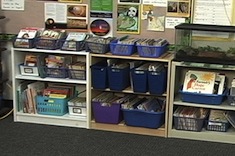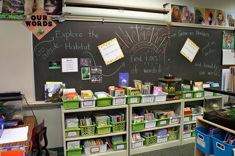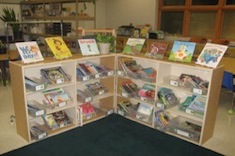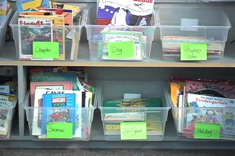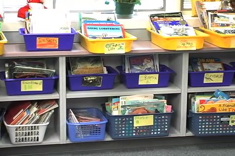It may sound like such a minor coaching experience, and yet it was so powerful. I was asked by a second-grade teacher to help reorganize her classroom library, so it would be easier for the teacher and students to use. This teacher, Miss Winter, had been teaching three years. She had an organization to her classroom library that was based on trade books set up alphabetically by the author’s last name, picture books set up alphabetically by title, and nonfiction books grouped in a science section, but not by any topics.
At the beginning of the year, I had given out a needs assessment with questions that asked about different literacy concepts (i.e. guided reading, read aloud, writing workshop, classroom library organization). Teachers indicated any areas they felt they would like to know more about, would like to have help with understanding, or have me model in their classroom. Miss Winter realized after three years of teaching that the way her books were organized confused children, rather than helping them gain independence in finding “just right” books or books of interest.
Miss Winter came to my classroom (I coach in the morning and teach the language arts curriculum in the afternoon to my primary multiage class) and noticed how the many books were organized, labeled, and accessed by my students. She hoped I could help reorganize her classroom library to be more like mine, targeting authors, themes, and titles in a way that was more accessible to students. Being asked to spend extended time in her classroom, with and without students in the room, gave me lots of opportunities for professional (and personal) conversations with this colleague. Building a personal relationship with this teacher helped to create a strong connection where she felt safe coming to me throughout the year with many different questions and inquires about teaching.
Miss Winter and I spent time before school looking around her room and discussing other options for organizing the books. She told me the way she had the books organized was based on a mentor teacher’s style from her first year of teaching. She knew she needed to make the books easier to find and put away. She was willing to go to a store and get many different size tubs to store the books and labels for marking them. We were able to empty a shelf that did not house books so that the books could be spread out more and allow for certain groups of books to be together in a similar location. I was able to see and hear exactly what went on with the students during the periods of time I was organizing the books. The organization of the books led to conversations with the teacher about reading instruction, grouping students, just-right books, books that serve as great examples for writing, and classroom design.
Timeframe and Categories
I spent about a week start to finish working in Miss Winter’s room. I changed the trade books into sections of series books and into tubs that had gradients of levels (easier, medium and harder).
I changed the picture books into tubs of:
- math books
- ABC books
- fairy tales
- author studies
- poetry
- literary nonfiction
- funny books
- favorites (these usually are asked to be read again and again and often include great examples of writer’s craft)
- fiction books
We took the science books and changed them into books grouped by topics:
- animals
- water
- seeds/plants
- space
- earth
- seasons
- body/nutrition
- transportation
- insects
- butterflies
- ants
- dinosaurs
- habitats
- maps
- people
- weather
At some point during each of the days I was working in her room, we would talk about what was the value of changing the organization and how certain books could be used. She learned about doing author studies, using books for read alouds to serve as models of a writer’s craft, the importance of students finding “just right” books for independent reading time, how to use more nonfiction literature across the day, and how to “eyeball” the level of a trade book (this would allow her to continue to buy and add more books to her collection independently). We even discussed some titles, authors, and books that she really needed to add to her collection as she gained points in the book clubs, applied for PTO grants, had classroom money to spend, or would purchase with her own money.
On the last day, we walked the students around the book area and described the books they could find there. They were oohing and aahing over getting the chance to read books that had been there, but had gone unnoticed because of the way they were organized. We made sure they understood the colored labels that marked the gradients of difficulty for the trade books. We made sure they understood the series books and where they would go if they read one of them. The students learned to know where to find a “just-right” book, how to find books that interested them, and how to put books back where they belonged.
Miss Winter shared that the class was so excited about the books now. It was like they had a whole new classroom library that was not only purposefully organized but more inviting to use. Other teachers heard Miss Winter bragging about her new set-up and how valuable it was to her and her students. She actually worked with another teacher on her team to reorganize that teacher’s classroom library. This positive response had other teachers looking at and thinking about their own classroom libraries. Several other teachers had me come in their room and look around at their organization or they came to see my room to get ideas. This also led to me going into teacher’s rooms and doing several “just-right” book talks with the students as the teacher would listen in and take notes for themselves.
What seemed like a minor coaching interaction turned into many coaching moments that had a direct impact on the way the teacher taught, the way the teacher stepped up to lead others, the physical set-up of her room, and student learning.

